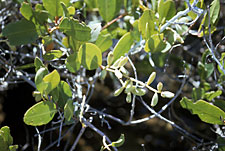![[Ocean Oasis Field Guide]](images/bnr-oo-field.gif)

![[Ocean Oasis Field Guide]](images/bnr-oo-field.gif) |  |
|
Laguncularia racemosa COMBRETACEAE (Combretum Family) 
DescriptionThis shrub can be recognized by the two bumps (glands) on the petioles of the leaves and its prominent stilted roots. The leaves are opposite, elliptical, rounded at both ends, 4-10 cm long, 2.5-5 cm wide; they are leathery, slightly fleshy, glabrous, and without visible veins. The flowers are in terminal spikes and bloom from July to October. It has grooved, almond-shaped fruits that are sometimes viviparous. Range and HabitatThis mangrove occurs in estuaries, and bays from Bahía Concepción to the Cape Region and on several islands in the Gulf of California. It commonly grows alongside Rhizophora and Avicennia. Natural HistoryReported to be astringent and tonic, White Mangrove is a folk remedy for dysentery (Duke and Wain, 1981). Hager's Handbook mentions that the bark is used for aphthae, fever, and scurvy (List and Horhammer, l969–1979). "The anti-tumor activity of the bark extract is attributed to its tannin content" (Morton, 1981). |
Text by Bob Lauri and Judy Gibson
White Mangrove — photo by Reid Moran
Mangroves
Field Guide |
Site Index |
Ocean Oasis Introduction
|
|
© 2000 San Diego Natural History Museum |